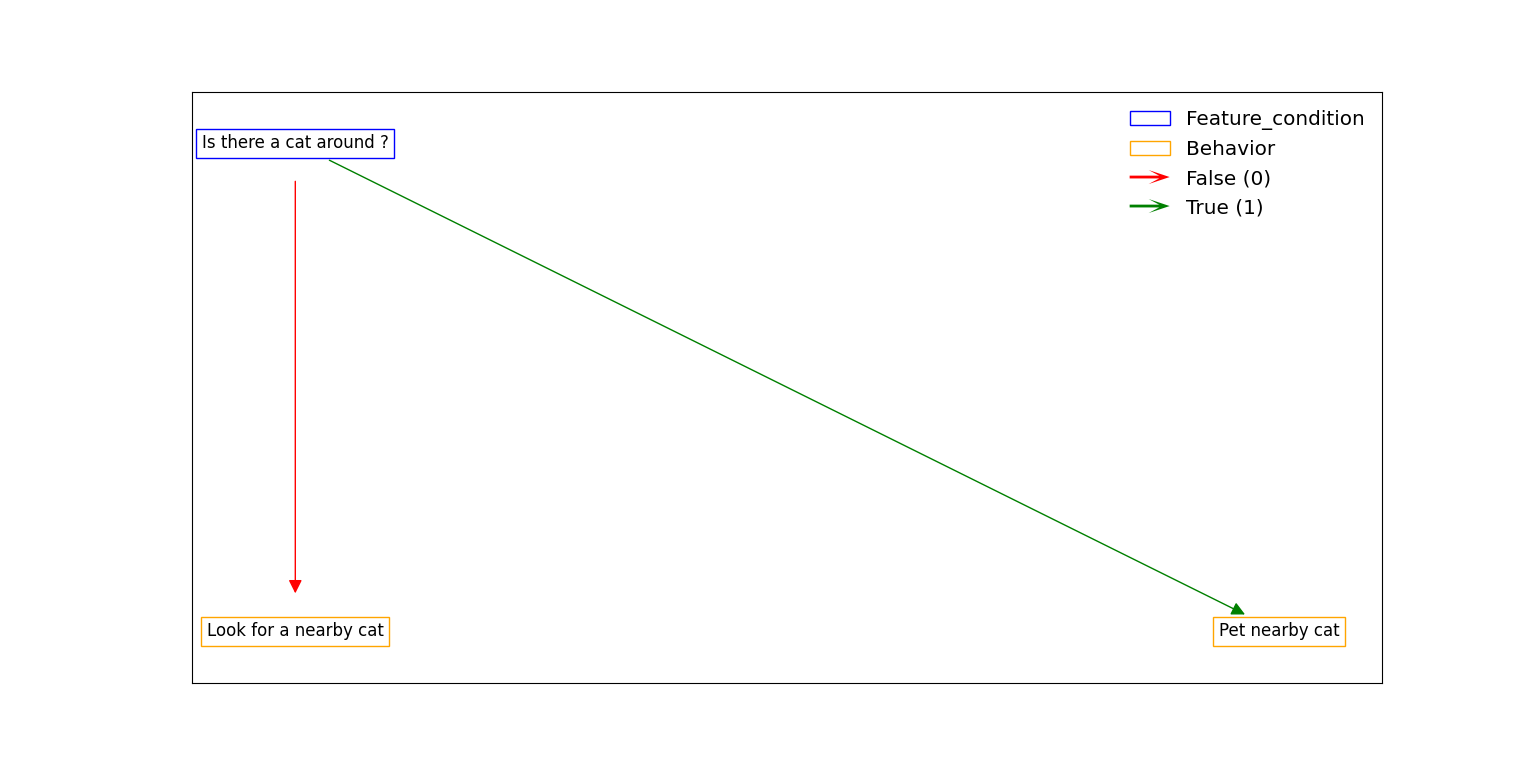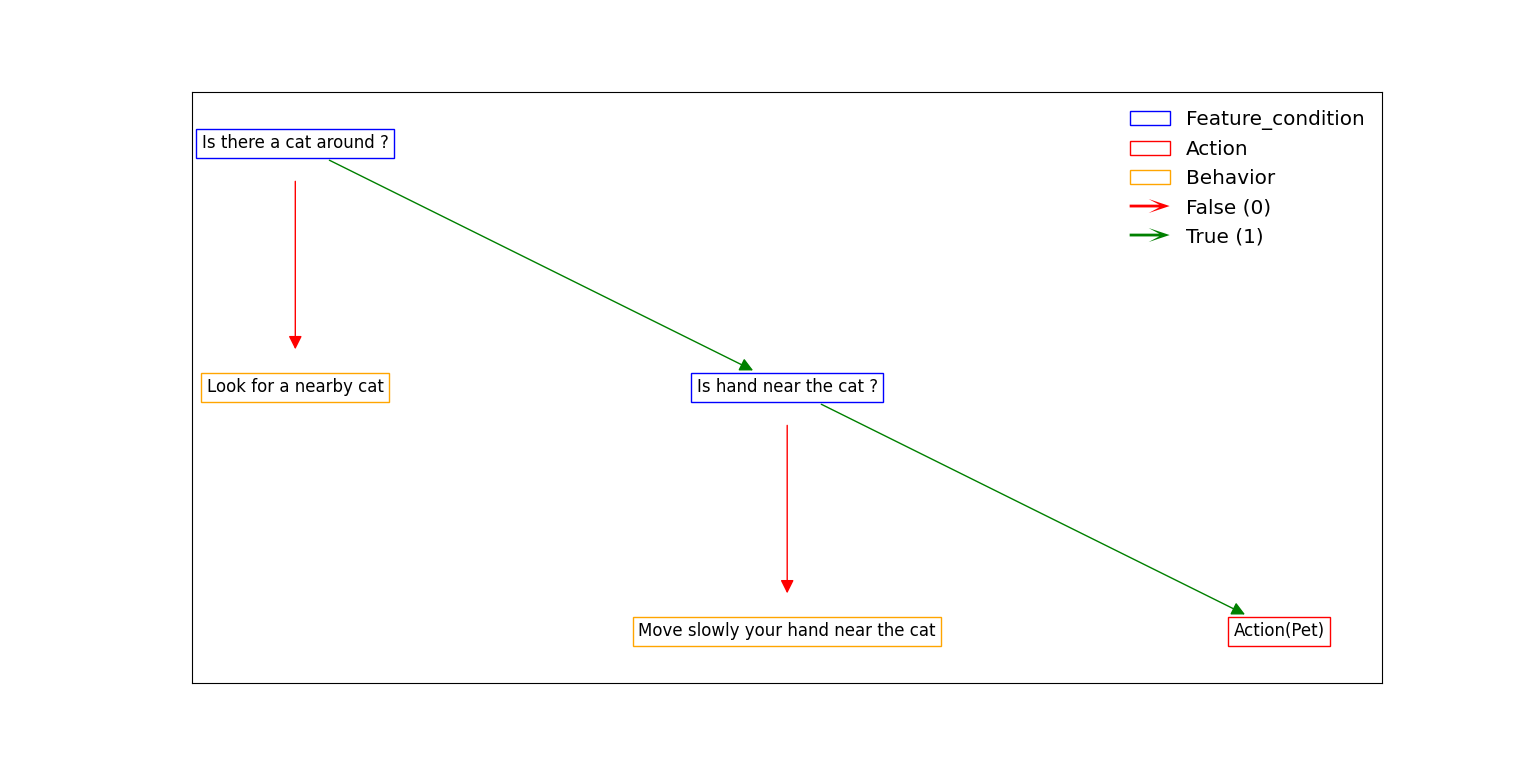![[PePy - Downloads]](https://static.pepy.tech/badge/hebg)
![[PePy - Downloads per week]](https://static.pepy.tech/badge/hebg/week)
![[CodeStyle - Black]](https://img.shields.io/badge/code%20style-black-000000.svg)
![[Licence - GPLv3]](https://img.shields.io/github/license/MathisFederico/Crafting?style=plastic)
This package is meant to build programatic hierarchical behaviors as graphs to compare them to human explanations of behavior.
We take the definition of "behavior" as a function from observation to action.
pip install hebgHere is an example to show how could we hierarchicaly build an explanable behavior to pet a cat.
"""
Here is the hierarchical structure that we would want:
```
PetACat:
IsThereACatAround ?
-> Yes:
PetNearbyCat
-> No:
LookForACat
PetNearbyCat:
IsYourHandNearTheCat ?
-> Yes:
Pet
-> No:
MoveYourHandNearTheCat
```
"""
from hebg import HEBGraph, Action, FeatureCondition, Behavior
from hebg.unrolling import unroll_graph
# Add a fundamental action
class Pet(Action):
def __init__(self) -> None:
super().__init__(action="Pet")
# Add a condition on the observation
class IsYourHandNearTheCat(FeatureCondition):
def __init__(self, hand) -> None:
super().__init__(name="Is hand near the cat ?")
self.hand = hand
def __call__(self, observation):
# Could be a very complex function that returns 1 is the hand is near the cat else 0.
if observation["cat"] == observation[self.hand]:
return int(True) # 1
return int(False) # 0
# Add an unexplainable Behavior (without a graph, but a function that can be called).
class MoveYourHandNearTheCat(Behavior):
def __init__(self) -> None:
super().__init__(name="Move slowly your hand near the cat")
def __call__(self, observation, *args, **kwargs) -> Action:
# Could be a very complex function that returns actions from any given observation
return Action("Move hand to cat")
# Add a sub-behavior
class PetNearbyCat(Behavior):
def __init__(self) -> None:
super().__init__(name="Pet nearby cat")
def build_graph(self) -> HEBGraph:
graph = HEBGraph(self)
is_hand_near_cat = IsYourHandNearTheCat(hand="hand")
graph.add_edge(is_hand_near_cat, MoveYourHandNearTheCat(), index=int(False))
graph.add_edge(is_hand_near_cat, Pet(), index=int(True))
return graph
# Add an other condition on observation
class IsThereACatAround(FeatureCondition):
def __init__(self) -> None:
super().__init__(name="Is there a cat around ?")
def __call__(self, observation):
# Could be a very complex function that returns 1 is there is a cat around else 0.
if "cat" in observation:
return int(True) # 1
return int(False) # 0
# Add an other unexplainable Behavior (without a graph, but a function that can be called).
class LookForACat(Behavior):
def __init__(self) -> None:
super().__init__(name="Look for a nearby cat")
def __call__(self, observation, *args, **kwargs) -> Action:
# Could be a very complex function that returns actions from any given observation
return Action("Move to a cat")
# Finally, add the main Behavior
class PetACat(Behavior):
def __init__(self) -> None:
super().__init__(name="Pet a cat")
def build_graph(self) -> HEBGraph:
graph = HEBGraph(self)
is_a_cat_around = IsThereACatAround()
graph.add_edge(is_a_cat_around, LookForACat(), index=int(False))
graph.add_edge(is_a_cat_around, PetNearbyCat(), index=int(True))
return graph
if __name__ == "__main__":
pet_a_cat_behavior = PetACat()
observation = {
"cat": "sofa",
"hand": "computer",
}
# Call on observation
action = pet_a_cat_behavior(observation)
print(action) # Action("Move hand to cat")
# Obtain networkx graph
graph = pet_a_cat_behavior.graph
print(list(graph.edges(data="index")))
# Draw graph using matplotlib
import matplotlib.pyplot as plt
fig, ax = plt.subplots()
graph.draw(ax)
plt.show()When ploting an HEBGraph of a behavior, only the graph of the behavior itself is shown. To see the full hierarchical graph (including sub-behaviors), we need to unroll the graph as such:
from hebg.unrolling import unroll_graph
unrolled_graph = unroll_graph(pet_a_cat_behavior.graph, add_prefix=False)
# Is also a networkx graph
print(list(unrolled_graph.edges(data="index")))
# Draw graph using matplotlib
import matplotlib.pyplot as plt
fig, ax = plt.subplots()
unrolled_graph.draw(ax)
plt.show()Note that unexplainable behaviors (the one without graphs) are kept as is.
Once you have a HEBGraph, you can use it to generate a working python code that replicates the HEBGraph's behavior:
code = pet_a_cat_behavior.graph.generate_source_code()
with open("pet_a_cat.py", "w") as pyfile:
pyfile.write(code)Will generate the code bellow:
from hebg.codegen import GeneratedBehavior
# Require 'Look for a nearby cat' behavior to be given.
# Require 'Move slowly your hand near the cat' behavior to be given.
class PetTheCat(GeneratedBehavior):
def __call__(self, observation):
edge_index = self.feature_conditions['Is there a cat around ?'](observation)
if edge_index == 0:
return self.known_behaviors['Look for a nearby cat'](observation)
if edge_index == 1:
edge_index_1 = self.feature_conditions['Is hand near the cat ?'](observation)
if edge_index_1 == 0:
return self.known_behaviors['Move slowly your hand near the cat'](observation)
if edge_index_1 == 1:
return self.actions['Action(Pet)'](observation)Whenever you encounter a 🐛 bug or have 🎉 feature request, report this via Github issues.
If you wish to contribute directly, see CONTRIBUTING

